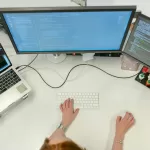Every student, regardless of their background, has an equal opportunity to succeed academically because to inclusive education. Its main goal is to let ordinary classes include children from many backgrounds, with disabilities, or who struggle so that they may still get the necessary help. Apart from promoting justice, inclusive education improves the surroundings for every student, therefore changing the institutions to be more pleasant to all. Why is the inclusive education important? Which benefits exist? How might this be done? These questions will help us to realize how inclusive education can let everyone perform in the classroom with efficiency.
To have “inclusive education“—what exactly does it mean?
In its most fundamental form, inclusive education is setting a stage where every student—from background to present, aptitudes to challenges—can learn together. This approach seeks to alleviate problems and eradicate assigning disabled students to different courses or institutions. Instead, inclusive education is the modification and adaptation done in regular classrooms so that every student may participate in the same kinds of activities and acquire the same knowledge.
Differentiating should thus be seen as a strength rather than a flaw in our method of teaching. Every student is unique and requires different kind of help if they are to function in the classroom. this is inclusiveness. Teachers and institutions should so make sure none of their students lags behind.
Why should everyone find a classroom friendly?
More than only inclusive learning decides depending on academic success. It teaches them respect and gets them ready for the several surroundings outside of the school. Students with and without disabilities learn beside each other and get along better as they accept and understand one another more. This improves their awareness of social concerns and sharpens their social abilities.
Inclusive education enables pupils with disabilities or learning gaps to participate. They are not alone as they can talk about their encounters with friends. This helps them to grow personally and raises their confidence. Good for all children, not only those with disabilities; they also pick up skills in handling people from diverse backgrounds and skill levels. This helps remove the negative notions people have of persons with impairments or learning challenges.
Why will openness of schools help them?
For teachers, students, the whole school community, and for everyone else as well. Of all the most important advantages are these ones:
Studies have shown that when attending those with other students rather than those with special courses, disabled children perform better in classrooms. They have to understand the content, accomplish more, and hang out with others who might serve as models.
In groups accepting everyone, people of all abilities find it easier to work together and create connections. Through group discussions, project-based learning, and supporting one another, students develop critical social skills like how to engage with one another, operate as a team, and solve problems.
Students who attend a university with a lot of different kinds of people are more likely to be empathetic and compassionate to others who have had different experiences and skill set. In the actual world, students pick abilities in socializing with people from many walks of life.
Feeling Like You Belong: Inclusive education gives each learner a sense of belonging. Children who feel valued and like they fit in their classroom are more likely to learn, participate in activities, and appreciate their school.
Working in friendly surroundings helps teachers learn how to make their classes more flexible and creative so they may serve the needs of students with varied learning styles and levels. Not only for the special needs students but also for the whole class gains from this professional growth.
Recommendation on the running of inclusive schools
Every student has different needs, hence effective schools must use policies and techniques that meet them. Open education depends on this as well. These are some pretty important strategies to address problems:
This method allows a teacher to change their lessons to satisfy every need of every one of their students. This implies that the courses, the teacher, or the assessments the students take need to be changed to ensure that every student achieves their learning goals and grasp the subject.
UDL is a teaching strategy aimed to let every student engage in education by designing flexible enough lesson plans to satisfy different demands. There are several ways to emphasis these elements: information is shown; expressiveness is how students present what they know; and engagement is how students tackle the issue. Using UDL ideas, teachers could help any student—from any kind of learner.
Interactive whiteboards, communication tools, and software turning writing into voice are among the helpful technologies accessible to disabled students to attend to class and totally participate in the lecture. Students who know how to learn, move, or hear better can help others follow directions and finish homework using these tools.
Regular and special education teachers will find considerable advantage working in inclusive groups. We know this as co-teaching. Both teachers grade students, instruct, and plan courses. They promise that every student gets precisely the right amount of help and attention.
Cooperation of classmates and teachers will help the classroom to be a better place for everyone. They can support and develop from one another in addition to helping each other with our projects. Helping less experienced or younger friends with projects is another excellent way to get everyone interested and a part of the group.
Problems on everyone’s school attendance
While every student is welcome in the classroom, if institutions and teachers are to run effectively some issues must be addressed by them. Here are some common problems:
Many institutions lack the tools, technology, or staff members required to carry out inclusive education with the required level of success. Teachers could thus find it challenging to carry out the required changes and help disabled students in need.
As a teacher, you might not know enough inclusive strategies to apply or how to help kids with different needs. Teachers have to be constantly learning and acquiring training to make sure they possess the tools needed for inclusive education carried out correctly.
Some management, parents, and teachers who are worried about how inclusive education will effect grades, classroom climate, or the provision of aid for disabled children could not wish inclusive education. Handling these problems helps one to show the benefits of open education.
Moving On: Future Education for Everyone Ahead
If we are to build a more fair and equal educational system, inclusiveness of education is more than just a fad. Schools have to evolve with society to meet the needs of every child. This covers funding for teacher training, streamlining tool access, and always developing learning methodologies suitable for numerous contexts.
With open education, every student—from any background or degree of intelligence—has chances to thrive. Not only help handicapped children; we want everyone to find studying more fun and interesting.
Inclusive education seeks to make the world a place where every child may learn, grow, and fulfill their full potential independent of their situation.









